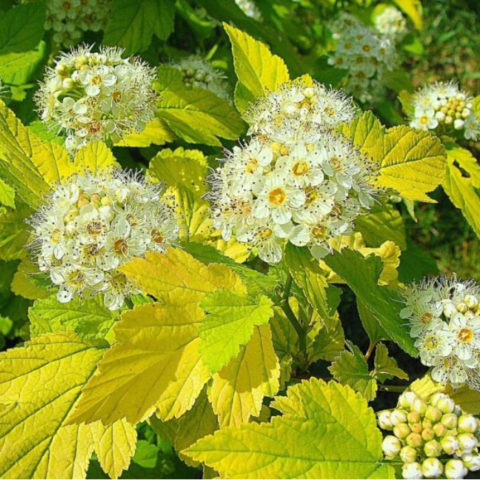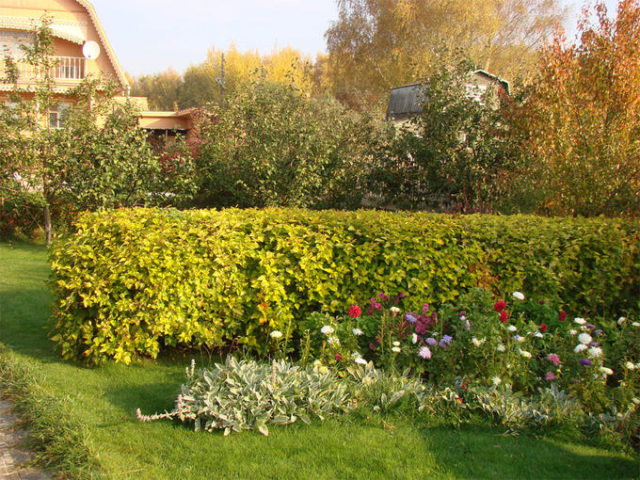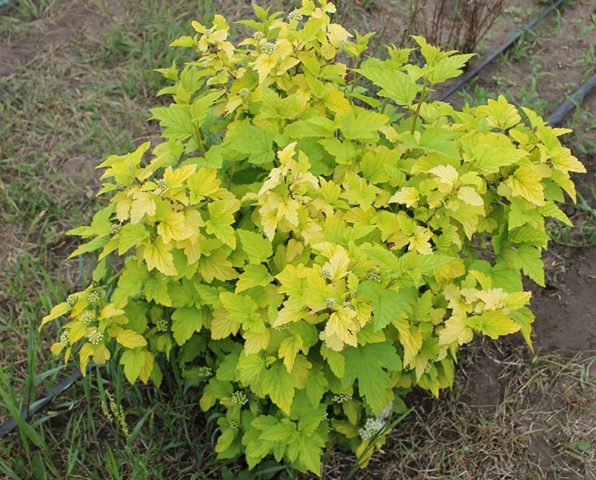Content
Only a few plants used in landscape design can boast of high decorativeness and unpretentiousness to growing conditions. It is to them that the Luteus bladder belongs, which designers have recently begun to use for landscaping areas. Luxurious, graceful shrub with a changeable shade of foliage, depending on the season, looks great in garden compositions, small park areas and hedges.
Description of the vesicle Luteus
Spectacular shrub Viburnum-leaved Luteus with a height of 2.5 to 3 meters has a spherical, spreading crown with somewhat drooping branches and large corrugated leaves, which gives the plant a delightful splendor from above to the very bottom. The Luteus variety, unlike other representatives of this species, has 3- or 5-lobed leaves. In addition, the variety is distinguished by the inconsistent appearance of the foliage. Dissolving in spring, it acquires a rich yellow color with a slightly orange tint, in summer it turns green, and in autumn it boasts a unique golden color.
The plant generously presents in June and early July with white small flowers, collected in beautiful inflorescences. Subsequently, instead of flowers, fruit-boxes of green color appear, which gradually acquire a red-brown color closer to autumn. Luteus, a bicarp, if you look at the photo, acquires special attractiveness in the fall, when the red fruits most effectively set off the lush gilding of the foliage.
Bubble-leaf Vine-leaved Luteus in landscape design
One of the most popular among the varieties of the bubblegum for landscape design is precisely the bubblecarp Luteus. Bright color of foliage, charm of flowers and spectacular fruits allow it to be widely used as:
- lawn tapeworm:
- in flower beds;
- under the canopy of larger bushes;
- in group plantings of the same species or different varieties of the vesicle;
- hedges.
The plant looks very unusual against the background or in group plantings with small deciduous shrubs or conifers - shrub cinquefoil, juniper, thuja. Bubble-leaf luteus of various colors in hedges can be safely combined with each other, which makes it possible to widely experiment in landscape design.
Growing conditions for the cultivar of the viburnum variety Luteus
An unpretentious shrub, undemanding to the soil and can easily tolerate shade. But it acquires the most spectacular and rich color only in sunny, open areas. Bubble plant Luteus is frost-hardy, only in rare cases young shoots can freeze slightly in cold winters. However, they are subsequently fully restored. The bladder has good resistance to pests and diseases, and is easy to cut. The plant does not tolerate stagnant water and limestone soil.
Planting and caring for the bladderworm Luteus
The soil for the bladder can be poor and loamy, but if it is loose and fertile, the plant will delight you with more luxurious flowering and lush forms. The shrub has only two requirements for the soil:
- it should be sour, without lime;
- there must be a drainage in it.
The plant is planted with seedlings in spring or autumn. Caring for the bladderworm Luteus consists in removing weeds and watering regularly, especially in the first time after planting and in drought.
Landing site preparation
For the good development of the whole plant, the rich beauty of foliage and inflorescences, a place must be selected well-lit, sunny. In partial shade and even in the shade, the viburnum-leaved variety Luteus will develop and bloom, but will not please with the brightness of colors and the splendor of the crown. When planting plants for hedges, planting holes for seedlings are dug at a distance of about 1 m.For group plantings, the distance is increased from 1.5 to 2 m.
Landing rules
At the bottom of the planting pit, half a meter deep, humus or peat is poured, and the seedling is installed along with the remains of the soil in which it originally grew. After that, the pit is sprinkled with soil and spilled abundantly, which will ensure rapid rooting.
Watering and feeding
Luteus, which is undemanding to care, still needs to be watered abundantly in dry summer, but making sure that moisture does not stagnate, otherwise it will negatively affect development. Twice a week, 40 liters of water is poured under each bush, at the very root. Abundant watering is also needed for the plant on poor, marginal soils. In other cases, the bushes are watered as needed.
Regular feeding will have a positive effect on the growth and development of the Luteus vesicle. From the beginning of spring, it is better to give preference to nitrogen fertilizers, which will ensure the splendor and beauty of the foliage. And in the fall - feed with minerals that will help the root gain strength and winter well.
- Spring feeding: 1 tbsp. l. ammonium nitrate and urea plus half a liter of mullein are diluted in 10 liters of water;
- Autumn feeding: 2 tbsp. l. nitroammophoska is diluted in 10 liters of water.
Pruning
Mandatory sanitary pruning in early spring is required for the Luteus bladderwort for an aesthetic appearance. For this purpose, damaged, dry, broken and frozen branches are removed. Forming pruning should be carried out regularly - as excess shoots grow, which will make the crown neat, dense and splendid. They cut it immediately after flowering, shortening the new shoots of the current year to about the middle of their length. The gallbladder is sheared twice a year: in late April or early May and in late June or early July. The first time - before the leaves bloom, the second - during the period of active growth. The plant tolerates pruning painlessly and quickly sprouts new shoots.
Judging by the description and photo of the Luteus vesicle, we can assume that its crown looks like a fountain, which is not suitable for all garden compositions. Therefore, to give it power and breadth, pruning of branches should be carried out at a height of 45 - 50 cm.But if the fountain-like shape needs to be made even more expressive, then it is worth cutting out thin shoots at the base, leaving no more than 5 of the strongest ones. To stimulate growth, these shoots are also pruned at a height of 1.3 - 1.5 m.
Preparing for winter
The bicarp of the Luteus variety is distinguished by good frost resistance and resistance to negative temperatures, therefore, it does not require a special shelter for the winter. In especially harsh winters, the tips of young shoots can freeze, which are cut off in spring during sanitization.
Reproduction of the bladderworm Luteus
The plant is propagated by cuttings, for which they take young, green shoots of the current year. Cuttings about 15 cm long are placed in a root-stimulating solution and planted in a sand-peat mixture. After watering, they are covered with plastic or cut-necked plastic bottles. Caring for cuttings of the viburnum bladder is reduced to regular airing and moistening before the onset of winter. With the arrival of cold weather, young seedlings are covered, and in the spring they are planted in a permanent place.
It is possible to propagate the yellow bladder or any other type of Luteus by layering, for which a small trench is dug near the main bush and the side shoots are bent, fixing them. Then add some soil and water it regularly. After rooting, the cuttings can be transplanted to a permanent place.
Video about bladder grafting:
Diseases and pests
The excellent resistance to diseases and pests of the bladderwort is another advantage of the culture. From waterlogged soil and lack of nutrients, yellowing of the leaves can be observed. This is how the plant signals improper care: it becomes a little weakened, which makes it accessible to pathogenic microorganisms and pests.
Conclusion
Bubble plant Luteus is able to completely cover up unattractive places on a personal plot in a very short time - within 2 - 4 years, create a dense hedge and create an unusually effective contrast in complex garden compositions. For its unique features and inimitable beauty, it is highly valued by landscape designers and has recently been increasingly used for landscaping city streets, squares, and park areas.












